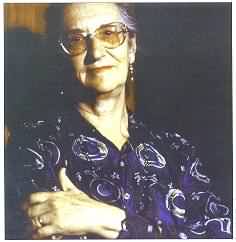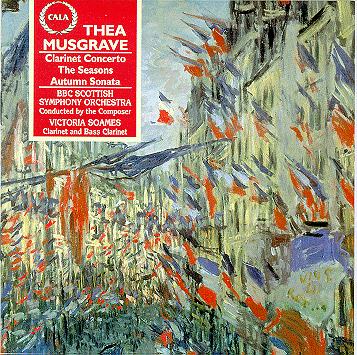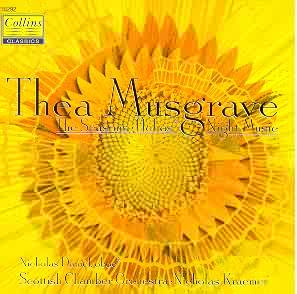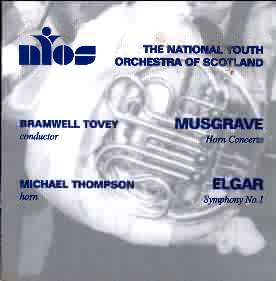 |

Here we have a dilemma.
For many composers we have a surfeit
of discs to choose from; for Thea Musgrave we
have only three and these come with reservations
- not, I hasten to add, over the performances
or the recordings, but over choice of couplings.
Two of the discs duplicate a major work and
the third has a less than satisfactory, or apposite,
coupling. All three are performed most fittingly
by Scottish orchestras and one is conducted
by the composer.
Thea Musgrave (1928 - )
read music at Edinburgh University under the
guidance of Sidney Newman and Hans Gal and
then studied with Nadia Boulanger in Paris
for four years (1950-1954). Her early compositions
were tonal, a style to which she later returned.
At a 1953 Dartington Summer School she met
William Glock and through his advocacy became
aware of the late Viennese serial composers,
Schoenberg and Webern, and also the compositions
of Charles Ives, whose influence can be heard
on The Seasons on two of the present
discs. Her compositions of the 1950's tended
towards chromaticism and the chamber opera
The Abbot of Dimmock (1955) incorporated
Schoenbergian sprechstimme. In
1958 she attended Tanglewood and met Aaron
Copland and Milton Babbitt ,and her work became
quite experimental. Eventually, she found
that style of composition limiting and inexpressive
and unsuitable for opera which has been her
main output and her last serial composition
was Sinfonia of 1963. Since then she
has forged her own path, her major output
being eight operas although no recordings
are available as far as I am aware. She married
and became resident in America and is still
actively composing, often with a particular
artist in mind such as Victoria Soames
in the bass clarinet concerto or as in Helios
written for Nicholas Daniel and the Scottish
Chamber Orchestra, both works are featured
on the recordings under review, performed
by their dedicatees.
Thea may have started out being
influenced by Schoenberg, Webern and her teacher
William Glock but that is not how I hear her
music at all (I have not heard any of her
operas). To my ears her music is modern
but approachable, sensitive and responsive
without any sudden unnecessary dramatic outbursts
that leave you wondering what on earth hit
you. Her compositions would certainly leave
the old ladies unruffled on the front row!
She does not write big tunes for her soloists
in the way Alwyn or Walton did - parts for
her soloists tend to be rather spiky but cushioned
by a lyrical underpinning in the orchestra.

Of the three discs under review, the starting
point for newcomers must go to the CALA release.
Cala is a small, enterprising, label owned
by the conductor Geoffrey Simon. All three
works are conducted by the composer who also
writes the programme notes in a dispassionate,
third person style, partially used here with
permission from Geoffrey Simon.
The Clarinet Concerto
(26:20)(Royal Philharmonic Society Commission,
1968) was written for Gervase de Peyer who
made the first recording (Argo ZRG726
8/75), which is rather academic as
it is not currently available and it is unlikely
Polygram will get round to re-issuing it.
The composer writes that the concerto depicts
a struggle between unequal forces - the individual
versus the crowd. The soloist begs support
from sections of the orchestra and does this
by the peripatetically moving to different
sections of the orchestra and persuading them
to play as separate units independently of
the conductor. This same idea is also taken
up in other works of hers such as the Night
Music for chamber orchestra which has two
horn players doing the same (ARGO 702
nla) and in the Horn Concerto (see
below). In one unusual alliance the soloist
pairs up with an accordian which is particularly
well caught in this recording.
I have always loved the sound
of the bass clarinet, particularly when used
by Shostakovich, but I have never previously
heard it used as a solo instrument in a concerto.
Again the sound has been beautifully caught
by the engineer (Graeme Taylor) and I have
been fascinated by the range of the instrument.
The Autumn Sonata is a dark,
brooding, atmospheric concerto in six parts
(21:38) and was commissioned by the present
soloist, Victoria Soames, who gave the first
performance at the Cheltenham Festival in
1994. Musgrave had previously set a poem by
the Austrian Poet, Georg Trakl, in "Wild Winter"
and was inspired to write this piece by other
of his writings. Each section of the Concerto
is prefaced in the score by short fragments
from four different poems. Thea Musgrave describes
each section as follows:
i Oscuro e misterioso
A dreamer approaches a dark menacing forest,
where crows scatter at the sound of black footsteps.
ii Svegliato
Mysterious dark forces awaken and bells toll
the alarm
iii Alla marcia, con furore
The echoing sound of deadly weapons erupts
and culminates in a pounding march, the major
climax of the work.
iv Lamentoso
Eventually the march subsides and the dark
flutes of Autumn greet the ghosts of heroes.
Here the ancient chant, Dies Irae, is embodied
in the musical texture in much the same way
as it was in the setting of the Trakl poem
in "Wild Winter".
v Oscuro e misterioso
A reprise of the opening section.
(Here we have the bonus of two Bass Clarinets
as an offstage instrument "shadows" the soloist
and the work momentarily becomes a double
concerto for Bass Clarinet.)
vi Adagio sostenuto
The coda where .... the music .... culminates
in a quotation from Beethoven's Moonlight
Sonata."
Finally the black mood is dispelled
and the music fades; was it really a memory
or just a dream?
The middle work on the disc is
orchestral: "The Seasons" (25:26)
and was a commission from The Academy of St
Martins in the Fields in 1988 to celebrate
the composer's 60th birthday; the first performance
was conducted by Sir Neville Marriner. This
work is in four movements (Autumn, Winter,
Spring and Summer) and each movement was inspired
by paintings rather than poetry. Musgrave
had visited the New York Metropolitan Museum
of Art and on viewing Piero di Cosimo's "Caccia
Primitiva", which depicts "a frightening
image of fire and destruction built around
a wild and gory hunt scene" she was struck
by the idea that various art works that depicted
the four seasons could also "become a metaphor
for the cycles in the life of man". This work
is tonal, tuneful, optimistic and very enjoyable.
The four sections follow without a break
The "Autumn" movement
was inspired by Caccia Primitiva
and Picasso's "The End of the Road"
and depicts a violent tempest. Raindrops plink
in the strings together with lightening bursts
from trumpets and percussion (including piano)
with the wind creaking in the contrabassoon.
Tubular bells have a prominent part
eventually intoning the Dies Irae as
the end of the road approaches. "Winter"
is despair in an icy landscape derived from
viewing Leutze's "Washington Crossing the
Frozen Delaware" Only a solo oboe gives
hope among the searching, crooning, string
phrases and there is a brief quotation from
the "Star Spangled Banner" which will
re-appear in Summer. The thaw comes in "Spring"
where the melt water dripping from the ice
is clearly heard, the awakening birds and
finally the cuckoo as the harbinger of spring;
the painting here was Van Gogh's "The Sower".
Finally "Summer", a movement
of rejoicing and celebration with extended
Ivesian section juxtaposing the Marseillaise,
the Star-Spangled Banner and enthusiastic
timps.. The paintings here were Van
Gogh's "Le 14 juillet a Paris", Jasper
Johns' "Flag" and Monet's "Rue St-Denis,
Festivities of June 30, 1878" (reproduced
on the cover above). For Nature this is the
final liberation from Winter; and for Man,
liberation from tyranny.
Glasgow City Hall is obviously
a good recording venue as the engineers have
produced a very natural recording with good
depth to the orchestra and a "hall feel" without
the undue resonance that BIS often achieve.

The Collins issue also includes the Seasons
which is coupled with Helios and
Night Music. Helios
[16.53] was premie../graphics/red at the
St Magnus festival, Orkney in 1995. Helios,
the Greek God who drove the sun chariot across
the sky is represented by an oboe (as Jennifer
Barnes's booklet notes point out, Helios was,
quite appropriately, the son of a Titan named
Thea). The piece depicts Helios traversing the
sky, having to ride through a storm, and slowly
fading peacefully on the other side in readiness
for another journey the next day. The disposition
of instruments here is interesting. The horns
and woodwind form a V shape with the trumpet
at the apex. This represents the chariot which
is pulled by four white stallions represented
by a flute, oboe, bassoon and clarinet/bass
clarinet, all sitting in a row in the apex just
in front of the trumpet. In front of them is
the massed strings creating the storm with the
solo oboe out front (Robin Williams). With the
aid of the booklet diagram this seating (and
standing) plan can be discerned in the recording.
Night Music [19.15] is
an earlier work from 1969 and was a BBC commission.
Musgrave describes this piece as a 'dream
landscape', a series of moods that shift rapidly
and unp../graphics/redictably. Here we have
two peripatetic horn players who at first
sit close, playing harmoniously together and
later move to the front, on either side of
the conductor, at some distance apart becoming
highly animated, with one finally slowly moving
off stage. Musgrave is recreating the waking
moments from sleep when the 'reality' of a
dream slowly slips away and consciousness
emerges. Whether intentional or not there
are, at times, strong resemblances in the
string writing to Schoenberg's Verklärte
Nacht ,with bowed strings floating high
over rapid pizzicato strings. We reach a loud
central choppy section with chirruping woodwind
and braying horns, not at all a nightmare;
just an active and pleasant dream from which
we slowly emerge. The two hornists are Robert
Cook and Harry Johnstone.
I find little difference in performance
between Thea Musgrave and Nicholas Kraemer.
Kraemer is perhaps punchier and a touch faster
in the two outer movements which whips up
the excitement a notch higher, particularly
in the Ivesian section of the final movement. The
Collins recording is more analytical with
the Cala having a more burnished sound with
more hall feel, This makes Winter seem colder
in the more analytical and slightly more distant
Collins recording. Thea is more involving
in the opening of Spring, possibly because
of the closer recording but also because there
is a smoother, more legato feel to the strings
with the woodwind and brass slightly less
intrusive. She is slightly slower in the final
movement but, as with Klemperer, this produces
a stronger sense of inevitability and forward
propulsion: the less is more approach. But
it is Kraemer and the collins sound who are
more confrontational in the Ivesian section. Both
are marvellous and make the music sound interesting
and attention grabbing which does not help
in a decision at all. The Cala does have the
imprimatur of the composer, who frequently
conducts her own works, and has the coupling
of two major works so has to be an eventual
first choice, if a choice has to be made.
This is not to decry the status of Helios
and Night Music which are both fascinating
works. I could not choose and just had to
purchase both.

The Horn Concerto was completed in
1971 and had a première recording from
Barry Tuckwell conducted by the composer and
coupled with the magnificent Concerto for
Orchestra (Decca Headline HEAD
8; never released on CD). The present
recording is the first on CD and is greatly
welcomed. As with many of Musgrave's works
there is an orchestral spacial context and
there is often an instrumental seating plan
prefacing her scores. In the horn concerto,
the percussion are arched around the back
of the orchestra, a trumpet on either side
and the trombone and four orchestral horns
as a group, who sometimes act as a reflection
so that the soloist's themes blast around
the auditorium, or even move out of the orchestra
and surround the soloist, who then pit themselves
eyeball to eyeball with the orchestra. Musgrave
rightly describes this style of work as "dramatic
abstract" and frequently use peripatetic groups
of instruments or soloists. As with all youth
orchestras, the students play with fervour
and dedication and I have no reservations
about Michael Thompson in comparison with
the earlier recording. This disc would receive
an unreserved commendation were it not for
the coupling which, to my mind, is unsuitable
and although extremely well played has a very
slow adagio in which all tension and forward
propulsion is lost. There are many better
recommendations for this work than this one.
The recording is superb with the soloist well
caught, and was made in City Hall, Glasgow,
produced by Andrew Keener. It is full price;
and I was prepa../graphics/red to pay
that for a work lasting only 22 minutes from
this 77 minute disc... but will you I wonder?
Even so it is still half the price of a concert
ticket, if one could actually anticipate the
chance of hearing this work performed 'at
a venue near you'. I have to split my vote.
Horn Concerto  Elgar
Elgar 
Len Mullenger
All these recordings
were personal purchases and not received for
review
|
Reviewer
Len
Mullenger
|



